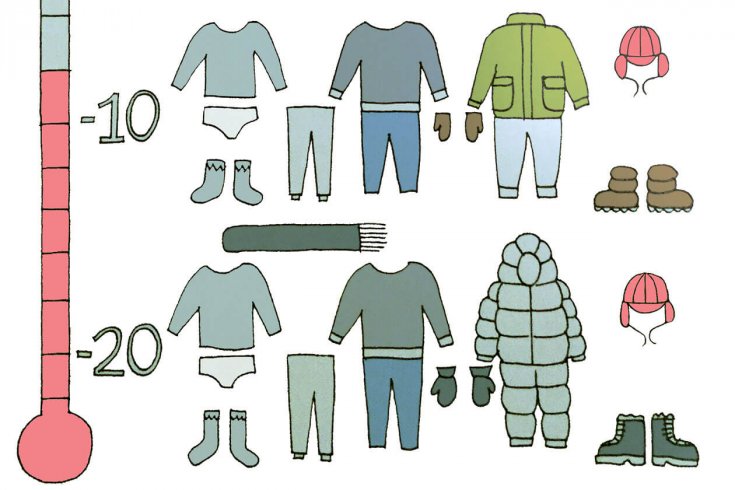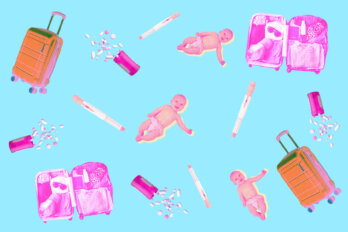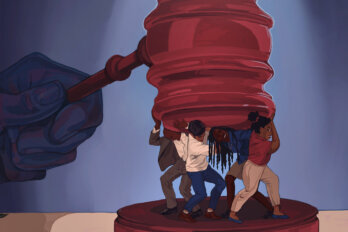A few years ago, a Russian pirozhok, or internet poem, made the rounds:
Oh mother, mother, can’t you see
The blackness pressing on our windows.
Please, please, don’t take me to the daycare
Through that infinity of ice.—Yyyt
It is a sentiment anyone who had a Soviet childhood can relate to. It describes exactly the way I felt every pitch-black winter morning when the poignant chimes of our alarm clock would wake me up. It was time to go to daycare. The alarm clock had been a gift to my mother by the department of biogeography upon her PhD defense at Moscow University, and for some reason played a melancholy Russian melody dating back to 1864 about the impossible desire on the part of a slender rowan to join a great oak growing far away across the river. Even now in my forties I cannot listen to it without wanting to cry. Back then a fount of infinite sadness seemed to well within me every time, I blinked tears back and the dreaded dressing for the day began. Uncomfortable tights that always twisted around one’s ankles, thick prickly woollen leggings, extra thick woollen socks, clumsy Valenki felt boots with galoshes that frequently fell off, numerous prickly cardigans, thick prickly woolly headscarf (or two), mittens sewn on to an elastic string. A heavy fur coat that felt like a suit of armour. Those were the markers of a 1960–’70s Soviet childhood. And then, once tightly wedged into the sled in all that clothing, the interminable ride through the snow under the forlorn pale street lamps unequal to dissolving the all-encompassing, icy darkness around us. I watched my mother’s back recede with longing as she, stumbling and slipping on ice patches, pulled the sled behind her, hurrying as much as she could so as not to be late to work.
It was easier in the evenings. There was that special hour when the snow turned an amazing shade of pale lilac, when the sky overhead deepened to dark green from the frost, and everything became magical—from the curiously shaped icicles on the tree branches (one could almost imagine them as different animals and fairy-tale creatures) to cheerful bright yellow windows which lit up here and there in the neighbouring apartment blocks as people came back home. And then the real night closed in and one watched and watched through the iron bars of the daycare gate (NO LICKING, or else!) for one’s mother coming to pick one up after work. My mother was often one of the last parents to show up, as the staunchly communist director of her research institute firmly believed in organising working meetings after 5 p.m. when work was officially over, because the intelligentsia “were parasites of the normal workers and had to be treated accordingly.”
Of course there were fun moments too, as in the daytime when one could toboggan down the steep ravine slope on one’s sled consisting of green and yellow wooden planks set on sharpish aluminium runners quite lethal when rammed into somebody, but those were not the days when people thought much about children’s safety. Then began the tottering ascent back over slippery icy pathway that grown-ups used to get into the ravine and back. The ravine was a huge one with several apartment blocks, daycare buildings, a drab grey hotel and a couple of ponds at the bottom. Later on, it also served as a ski slope, oh those horrible skis with unwieldy iron bindings that kept coming off one’s boots—one of the singular miseries of my childhood. My heroic mother made me ski all the way to the library on winter weekends, along the busy highway which reeked of petrol fumes (a full metro stop away), but it was the only kind of sporting activity she could force on me. Anyway, the library was a big inducement. There were the old forgotten fairy-tales in English that I never found in Russian in Soviet times. Even the names were enchanting: The Little Lame Prince, The Secret Garden, Anne of Green Gables, Once on a Time, The Princess and the Hedge-pig, and so on. So one did ski there losing one’s skis all the time but trudging on, and then shed all of those prickly, scratchy woollen layers to enjoy a couple of blissful hours wandering around the shelves, smelling that particular scent of old books, pulling out volumes at random, and so on, definitely a silver lining.
Many years later my husband and I came to Canada in the mother of all snowstorms. It took several tries for our plane to land at Pearson, but even though I am a real coward I was past caring at that stage. I was coming to Toronto as a landed immigrant, and felt as if suspended in the giant snow bubble impervious to emotions. The formalities were over soon enough, we stepped outside, hailed a taxi, and went downtown. The storm was over by then, under the deep dark sky the snow lay calm and dazzling white everywhere as far as the eye could reach. We went past various neighbourhoods hardly discernible under thick snowy blankets, soundlessly rolled into the Annex, and came to a strip of beautiful Victorian houses that looked like the perfect backdrop for a Christmas card. We were to stay at a generous friend-of-friends’ until we found our own place. That evening we ventured out to a Hungarian eatery on Bloor Street, the last remnant of the great Hungarian diaspora that paved way for the exciting multicultural Toronto of today. During our seven years in Canada, I talked to many people who remembered that old Toronto and the amazing changes that had unfurled under their eyes. But right after our arrival I knew nothing and went on floating around in my personal frosty bubble of snowy silence, taking stuff in as if through a thick translucent veil—comfortably numb. Honest Ed’s, the Korean supermarket where I first discovered chipotle, the Italian cheese shop whose owner suggested I rent the basement of her house, dark scruffy pubs with their weak beer, Harbord Bakery with its gefilte fish and challah, the late snow-capped roses of the local gardens which had been caught quite unaware by that season’s first snowfall when it finally happened, on January 15.
And it was on another January 15, six years later in 2013, that our son was born. A couple of days later, bundled in everything warm we could find except the snowsuit—that would be against hospital safety regulations for newborns—he was settled in the back of the car besides his dozing big sister, then two years and three months old. The car was borrowed from our wonderful Harbord Village neighbours and we were coming home. And I was back in my bubble of snowy silence although now it included my family as well. It felt like we were alone in the world, adrift, the only people on earth in a little car slowly and very carefully rolling down the empty Bathurst Street covered in a thick layer of snow with huge snowflakes slowly floating down from the sky. New life was beginning—what kind of life, I had no idea and cared less, protected from the future by that immense snow blanket.
It was in Toronto that I was fully exposed to the winter bundling battle from the parenting side. Of course modern winter attire is much more handy than what I had to wear in my childhood, but modern children still perceive it as an evil straitjacket and will do anything imaginable to fight for freedom, from strident bawling to lightning-fast wriggling out of the extremities already bundled into the snowsuit while the sweating parent is trying to get other extremities in, with the result that once these are in, the previous ones are already out, and so on. In short, one cannot but be thankful that humankind is not built along the lines of octopi.
But snowsuits are, of course, imperative for making proper snow angels, something that I wasn’t familiar with in my childhood. The process should be crowned with cocoa and marshmallows afterwards—but for some reason we never took to that particular aspect of the New World cultural tradition (I guess marshmallows are an acquired taste). Otherwise winter in Toronto with its early dark and high snowdrifts seemed perfectly familiar. The fun part was that because we lived in the basement of a beautiful Victorian house with a tiny garden in the front and a backyard we got a bonus and could shovel the snow to our hearts’ delight. As former residents of apartment blocks with no previous snow-shovelling obligations this made us extremely happy, although it never failed to surprise our landlords.
And, of course old Christmas carols in English and French, and Canadian songs like “Frozen in Frobisher Bay,” sung by friends in pubs, clubs, and at home; Christmas pantomime at the Tranzac Club; neighbourhood Christmas and Hanukkah parties; the sing-along Händel’s Messiah and The Nutcracker; Chinese New Year on Spadina; Burns Night; all integral parts of the Toronto winter that we miss now that we have moved again, and find ourselves in Helsinki, Finland.
Here in Finland, people take their outdoor activities seriously. In the daycare where our children go, there is a precise chart displaying exactly what a child should wear at which temperature, no recourse to the airy advice previously given us by our beloved Canadian doctor: “One more layer than the number of layers the parent is wearing”—or was that for babies only? The dazzling array of socks, double socks, mittens, double mittens, hats, and scarves recommended here is rather intimidating, but then Finnish children are supposed to spend a lot of time outside, the principle being that a little rain or snow never hurt anybody. Also there are special rubber overalls to cover the snowsuit. I must confess it works very well, protecting the child from slush and dirt. My never-hurt-a-fly mother-in-law once completely lost it back in the 1980s and whacked my future husband when he showed up back from preschool plastered with mud for the second day in a row, having been explicitly forbidden to play in that particular muddy area. Soviet apartments almost never had dryers, so trying to wash stuff in the evening for the next morning was a nightmare. In Finland the protective rubber overalls are simply hosed down, leaving the clothes beneath them, such as snowsuits, clean and dry. Finns love their winter fun and one would be hard put to find any complaints when snow is announced on local weather websites; mostly, online comments erupt with cheers and other enthusiastic responses ( “High time,” “Finally,” “Can’t wait”).
There is also the sauna, the great Finnish invention. Old apartments have a communal sauna, besides the many public saunas in the city, but in our building that dates from the 1990s each apartment has its own electric sauna. Of course we cannot plunge straight into the snow or into the icy lake after using it as many Finns love doing, but a built-in sauna has its own compensations. Imagine coming in from the cold, shedding all the frozen outer and inner garments and rushing into the toasty warmth of the preheated sauna, all after having walked for hours over the frozen sea, playing explorers and managing to explore over ice islands in the bay that aren’t even accessible by public boat service in summer. Granted this includes a pit-stop with generous portions of hearty Finnish salmon soup and mugs of ubiquitous coffee (Finns take special pride in drinking more coffee per capita than any other nation) in a little log cabin café right by the marina twinkling with fairy lights in the early winter dark and looking like a place out of Tove Jansson’s Moomin books.
Actually, fairy lights are very important here: there’s not much sun in winter, to put it mildly, and the season is long. So Finns fend off the encroaching winter darkness in any way they can. This year I spotted the first lights glinting on our building in mid-September and the closer we get to winter the more lights are seen in windows and on balconies everywhere. When I come back from work by bus in the winter darkness I always watch the apartment buildings right on the seafront. The closer to the winter solstice we get, the more beautiful lights they sport, and I spot new ones every time, until around Christmas when the buildings become like giant festive cruise boats all decked out in myriad lights, silver, white, gold, sometimes multicoloured, with silhouetted Christmas trees sparkling here and there, all this splendour reflected back in the glossy black mirror of the winter sea, before it freezes solid in January. Winter solstice is taken very seriously in Finland, from the day of official lighting of city Christmas decorations in late November to Finnish Independence Day on December 6, when people light pairs of candles in every window. Finns also honour their departed family members on Christmas Eve, leaving lighted lanterns at their graves. Recently a festival of light has been instituted for early January, so there’s no lack in light warfare against winter darkness.
This makes sense, for our trouble with winter is as much about the darkness as it is about the actual cold. On balance, however aggravating it is, one can always bundle up like Jason, the hero of Robert Munsch’s brilliant 50 Below Zero—a book inspired by the author’s visit to Watson Lake, Yukon. Three warm parkas, three warm snowsuits, six warm socks, six warm mittens, mukluks, and one is all set, but it is the winter darkness that ultimately gets to us. So I am all for fairy lights, Advent wreaths, Hanukkah menorahs, New Year fireworks, whatever, bring it on, anything to preserve our sanity and survive the darkest part of the year, the winter of our discontent, until sun gradually returns bringing back the light.





